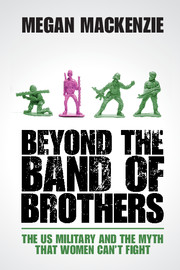Book contents
- Frontmatter
- Dedication
- Contents
- List of tables
- Acknowledgments
- Introduction: myths, men, and policy making
- 1 The combat exclusion is a story we tell ourselves … about men
- 2 The disintegration of the combat exclusion in Iraq and Afghanistan
- 3 It just doesn't feel right: emotion and the combat exclusion policy
- 4 Faster, stronger, more male: women and the failure of physical standards
- 5 Sex, cohesion, and national security
- 6 Using online debates to map public reaction to the combat exclusion
- Conclusion
- Bibliography
- Index
2 - The disintegration of the combat exclusion in Iraq and Afghanistan
Published online by Cambridge University Press: 05 July 2015
- Frontmatter
- Dedication
- Contents
- List of tables
- Acknowledgments
- Introduction: myths, men, and policy making
- 1 The combat exclusion is a story we tell ourselves … about men
- 2 The disintegration of the combat exclusion in Iraq and Afghanistan
- 3 It just doesn't feel right: emotion and the combat exclusion policy
- 4 Faster, stronger, more male: women and the failure of physical standards
- 5 Sex, cohesion, and national security
- 6 Using online debates to map public reaction to the combat exclusion
- Conclusion
- Bibliography
- Index
Summary
As Chapter 1 illustrated, the combat exclusion has always been a fluid idea evolving over time. It is argued in this chapter that the wars in Iraq and Afghanistan extinguished any remaining practical applicability of the combat exclusion, rendering it a catchphrase rather than an enforceable policy. This chapter examines the modern history of the combat exclusion policy. In doing so, it continues to contrast the “reality” of women's contributions to war to the “fantasy” of the all-male combat unit. This chapter also outlines the context for subsequent chapters, which consider the rationale behind the decision to remove the combat exclusion and the depiction of this decision as a watershed moment. The chapter points to the efforts to sustain the combat exclusion during the Iraq and Afghanistan wars, despite evidence indicating it was unenforceable, unnecessary, and potentially detrimental to the security of soldiers. Evidence of women contributing to combat operations was routinely met with political efforts to reinforce the perception that women were not in combat. This chapter illustrates that during the wars in Iraq and Afghanistan – which saw the disintegration of front lines and the removal of most of the mechanisms available to keep women from the so-called front line – the efforts to sustain the myth of the all-male combat unit became increasingly desperate and, at times, absurd.
Three central arguments drive the chapter. First, the nature of military operations, and the assignment and contribution of women in both wars, made the combat exclusion unenforceable. The realities of insurgency warfare in Iraq and Afghanistan have rendered divisions between front lines and rear units irrelevant. Women were consistently part of hostile military operations; bureaucratic division between combat and support units did not shield women from the reality of military operations. Moreover, the US military has made several policy and structural changes that have served to remove the final thread holding the combat exclusion in place.
- Type
- Chapter
- Information
- Beyond the Band of BrothersThe US Military and the Myth that Women Can't Fight, pp. 42 - 74Publisher: Cambridge University PressPrint publication year: 2015



